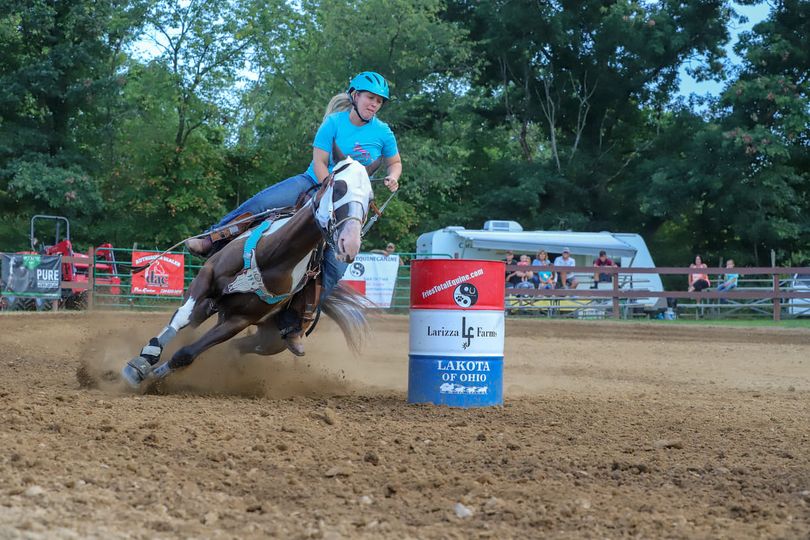Barrel racing started in 1928 in Stamford Texas. It originally had only two barrels and horses and their riders would run a figure eight around them. It wasn’t until 1935 that the third barrel was added, and the clover pattern was started, but it wasn’t recognized as a sport until 1948. In 1949-barrel racing became what we know it to be today, with riders and horses being judged for the fastest time around the barrels without bumping or knocking them over. Horses and riders are, however, allowed to touch the barrels; they just can’t be bumped or knocked over. If a barrel is bumped or knocked over extra time will be added to the racers final time. For each barrel that is knocked over it is usually a five second penalty added to the rider’s time, so if all three are knocked over it will be a fifteen second penalty!
The way barrel racing is judged is usually in a 4D format. What this means is you have the 1st division being the fastest time, the 2nd division being the fastest time plus half of a second, the 3rd division being the fastest time plus 1 second and the 4th division being the fastest time plus 2 seconds. There can be variations on how barrel racing is judged, sometimes they will judge in a 3D or 5D format which is the same set up as the 4D, but you stop at the 3rd division in 3D and for 5D the 5th division is the fastest time plus 4 seconds. Depending on the type of barrel race you are running and how it is being judged these times can change slightly.
There are also different categories of barrel racing: Divisional, Jackpot, Futurity, and Rodeo.
- Divisional: Probably the most well-known amateur barrel racing event. This event attracts a lot of competitors which can make the race last quite a while, especially since this race is run one racer at a time. The ground conditions at divisional barrel races are usually in good condition which helps horses get their footing for their turns easier.
- Jackpot: The same as divisional barrel races but the payoff is higher for the riders. Ground conditions are usually good in this version of barrel racing as well.
- Futurity: These races are for the future barrel racing horses and their riders. Only younger horses, between 4-5 years old, are to be entered in futurity races. You do not want to enter a horse that is too young into barrel racing because their bones and joints have not fully set, and barrel racing is tough on horse’s joints so this could cause injury that might not be able to heal for your horse. The ground conditions at futurity barrel races are the best out of all four categories of barrel racing.
- Rodeo: Very well-known among riders and people who aren’t as involved in horses and racing. Rodeo’s draw an extremely large crowd which can be a little bit intimidating for horses and their riders. Ground conditions are not ideal at the rodeo due to all the activity on them. Since ground conditions aren’t as good here, the riders really have to help their horse in their turns. With the three prior categories of races, since the ground conditions are consistent at each race, their horse can get into a groove of running. Whereas in the rodeo, the grounds can vary at each race, which means that the horse and their rider must engage with each other that much more.
Choosing the right horse is also a big factor in barrel racing. Each breed has their own qualities that make them excel at some activities and perform poorly at others. Considering how well you can train your horse, their endurance, speed, agility, and their temperament can all help you in finding the right horse for your competition. A few different breeds to consider for barrel racing are the American Quarter Horse, American Paint Horse, Thoroughbred, and Appaloosa.
- American Quarter Horse: Known for their speed, versatility, agility, and gentle nature, the American Quarter Horse is a great choice for barrel racing. With their gentle nature and calm temperament, training this horse is great for beginners and seasoned riders. It is easy to form a strong bond between an American Quarter Horse and their rider which helps them dominate in barrel racing, they do particularly well in rodeo if that bond is built with their rider.
- American Paint Horse: Known to have a very friendly and easy-going temperament, training this breed is great for beginners. They also have great stamina, speed, and strength. If you are a first-time barrel racer, choosing an American Paint Horse might be the way you want to go. They are a top choice for trainability.
- Thoroughbred: Known to be very spirited and bold, with a lot of stamina and strength. A Thoroughbred is not necessarily a horse that you would want to choose if you are a beginner, due to their spirited nature. Though they are highly intelligent and have a sensitivity to their nature, they are not always as easy to train. For more seasoned riders, a Thoroughbred is a great choice. They have a lot of energy, a willingness to learn, and excel in whatever event they are put in.
- Appaloosa: Known best for their unique coat! Appaloosas have a very easy-going temperament which makes them great for beginning riders. They are very independent and can be extremely courageous and fierce when in competitions. Along with their easy-going temperament, Appaloosas are very calm and loyal, which makes them a great choice for building a long-lasting relationship between the horse and rider.







